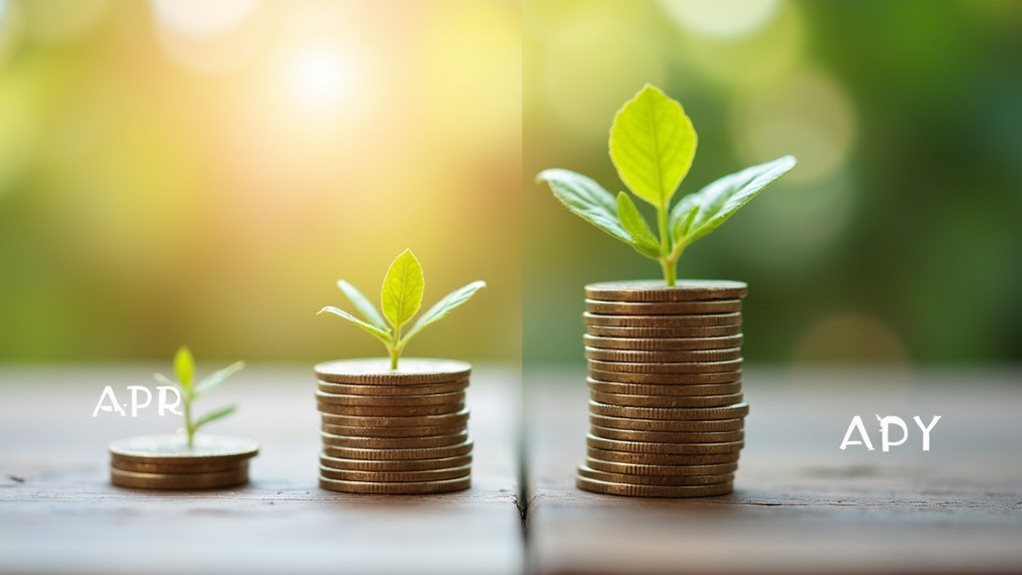APR and APY might look similar, but they're totally different beasts. APR shows what you'll pay in interest when borrowing money – like with credit cards or loans. APY, on the other hand, reveals what you'll earn on savings through compound interest. The key difference? Compounding. APR typically ignores it, while APY embraces it like a long-lost friend. The more frequently interest compounds, the higher the APY climbs. But there's way more to this financial story.

When it comes to financial terminology, APR and APY might seem like nearly identical acronyms. But these three-letter terms couldn't be more different in how they affect your wallet.
APR, or Annual Percentage Rate, measures what you'll pay in interest when borrowing money, including those sneaky additional fees lenders love to tack on. APY, or Annual Percentage Yield, tells you how much you'll earn on your savings when you let compound interest work its magic. Good credit scores typically result in more favorable APR offers from lenders.
APR reveals the true cost of borrowing, while APY shows how compound interest can grow your savings into something spectacular.
Think of APR as the bad guy in your financial story. It's what credit card companies and loan officers wave around, usually in the tiniest possible font. While APR typically doesn't include compound interest for loans, credit cards are a different beast entirely – they'll compound that interest faster than you can say "minimum payment."
And here's the kicker: the higher the APR, the more money you're kissing goodbye.
APY, on the other hand, is your friend in the savings world. It factors in not just the basic interest rate but also how often that interest compounds. The more frequent the compounding – daily, monthly, annually – the higher your APY becomes. It's like interest on steroids, but completely legal. Some banks like Varo offer up to 5.00% APY on savings accounts when certain conditions are met.
The formula might look intimidating: APY = (1 + R/N)^N – 1, but the concept is simple: more frequent compounding equals more money in your pocket.
Financial institutions are legally required to disclose both APR and APY to consumers. It's not because they're feeling generous – it's the law. This transparency helps people compare different financial products, though let's be honest, most folks would rather watch paint dry than read the fine print on their credit card statement.
The frequency of compounding makes a huge difference in both cases. With APY, more frequent compounding is like finding extra money in your coat pocket – it's a pleasant surprise that adds up over time.
But with APR, especially on credit cards, frequent compounding is about as welcome as a root canal. Those daily compounding rates can turn a seemingly manageable interest rate into a debt monster.
Remember this: APR is what you pay, APY is what you earn. It's that simple.
And while both rates can be variable, meaning they change over time, the basic principle remains the same. One takes money out of your pocket, the other puts it in. Financial institutions compete based on these rates, which at least gives consumers some options in this complex financial world.
Frequently Asked Questions
How Often Do Banks Update Their APY Rates?
Banks don't update APY rates on any fixed schedule – they're pretty unpredictable about it.
Most changes happen after Federal Reserve meetings or significant market shifts. Some banks might tweak rates monthly, while others sit tight for months.
Online banks tend to be more aggressive with updates.
Truth is, it's all about market conditions and competition. When the Fed makes moves, banks usually follow suit – eventually.
Can APR or APY Be Negative in Certain Economic Conditions?
Yes, APY can technically go negative – it's rare but it happens. Just ask some European banks that have charged customers to hold their money. Wild, right?
APR, though? That's a different story. While true negative APRs don't exist (banks aren't paying you to borrow money), some loan incentives might create an effect that feels like negative APR.
Think rebates or special promotions. But don't get too excited – these are marketing tricks, not free money.
Which Rate Do Credit Card Companies Typically Advertise and Why?
Credit card companies typically advertise APR, not APY.
It's the law – the Truth in Lending Act requires it. They must show the Annual Percentage Rate clearly to help consumers understand their true borrowing costs.
While they sometimes highlight monthly rates in promotions, that APR disclosure has to be there.
Funny enough, they love plastering those sweet "0% APR" intro offers everywhere, but the regular APR always lurks in the fine print.
Are APR and APY Calculations Regulated by Government Financial Authorities?
Yes, APR and APY calculations are heavily regulated.
The Consumer Financial Protection Bureau (CFPB) and Federal Reserve enforce strict rules about how these rates must be calculated and disclosed. They're not just making this stuff up!
The Truth in Lending Act requires lenders to disclose APRs transparently, while banking regulators monitor APY disclosures for deposit accounts.
Break the rules? Expect fines and penalties. Financial institutions face regular audits to guarantee compliance.
How Do International Banks Handle APR and APY Across Different Currencies?
International banks face quite the juggling act with APR and APY across currencies.
Exchange rates make everything trickier – they're constantly shifting. Banks typically add extra fees and higher rates to cover currency risks. They use hedging strategies to stabilize things, but it's complicated.
Different countries have different rules too. Local economic conditions and inflation rates play a huge role.
Bottom line: cross-border banking isn't for the faint of heart.









